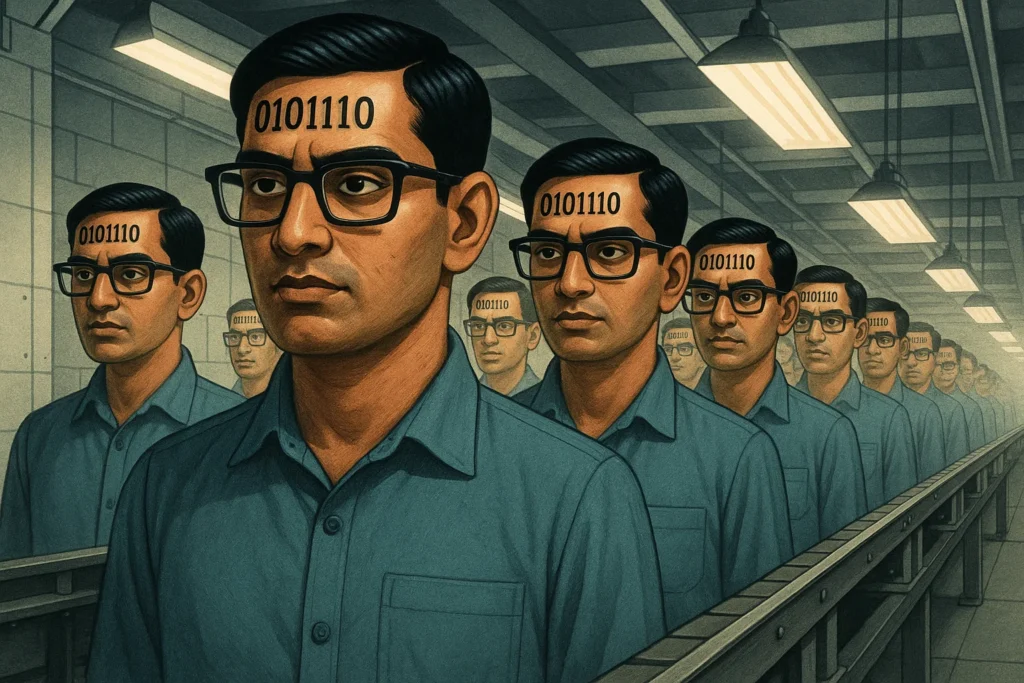If you work in tech, you’ve encountered the stereotype: the notion that Indian professionals possess an innate, superior aptitude for technology and engineering. This idea is so pervasive it’s often accepted as an unspoken truth, a natural law of the corporate world. But what if this perception isn’t based on reality, but is instead a carefully manufactured narrative designed to serve specific economic and ideological goals?
The myth of the “tech-savvy intelligent Indian” is not an organic cultural observation. It is the product of selective perception, corporate exploitation, and geopolitical strategy. It’s time to dissect its origins and understand why this convenient fiction persists.
The Genesis: Outsourcing and the H-1B Visa Program
The myth began to solidify in the 1990s and early 2000s. U.S. corporations, particularly in the tech sector, made a calculated discovery: they could drastically cut costs by outsourcing IT work offshore or by importing cheaper labor directly through H-1B visa programs.

However, replacing American workers with foreign labor required a justification. Thus, a powerful PR campaign was born. The narrative became:
“We can’t find enough qualified Americans, so we must bring in these brilliant, highly skilled Indian workers.”
This clever framing transformed a simple cost-saving measure into a supposed necessity, inventing a mythical “skills gap” to mask the true motive. The reality was often starkly different: companies were frequently importing workers of average ability whose primary qualification was a willingness to work for less and accept conditions American workers would not.
The “Model Minority” Trojan Horse
This stereotype is a specific application of the broader “model minority” myth. It is an incredibly useful tool for the establishment elite. It serves to pit minority groups against each other while simultaneously silencing dissent from native workers. The implied message to American professionals is:
“If these immigrants can succeed where you struggle, your failure must be your own fault.”

It paints a picture of a hyper-competent, apolitical, and compliant workforce that doesn’t challenge the system—a perfect employee class for corporate managers focused solely on the bottom line.
The Illusion of Selection Bias
With a population of 1.4 billion people, India produces a massive number of graduates. The tiny fraction that secures visas to Western nations often comes from the upper strata of society and represents a selected group—the top percentile of a vast pool.
This creates a powerful illusion. For every Indian engineer at a FAANG company, there are countless others with mediocre skills or even fraudulent credentials who nonetheless benefit from this inflated collective reputation. We are seeing a filtered sample and mistakenly applying its traits to the entire group.
The Imported Hierarchy: Caste, Clan, and Corporate Fiefdoms
The myth of universal Indian tech prowess obscures a far more complex and divisive internal reality: the importation of subcontinental social hierarchies into the Western workplace. The same system that produces a filtered, seemingly homogeneous group of professionals does not strip them of deeply ingrained cultural behaviors, most notably the dynamics of caste and regional favoritism.
What management often celebrates as “diversity” is, in practice, the seeding of ancient tribal loyalties into modern corporate structures. This manifests in a predictable pattern:
- The Gatekeeper Hire: Once an individual from a specific region or caste (often a forward caste like Brahmin or Bania from states like Andhra Pradesh or Tamil Nadu) attains a position of influence—as a hiring manager, team lead, or particularly a director—the hiring patterns shift dramatically. The criteria for new hires becomes less about objective merit or cultural fit with the company and more about jati (caste) and beta (regional kinship).
- The Building of Fiefdoms: These managers proceed to staff their departments overwhelmingly with individuals from their own linguistic, regional, and caste backgrounds. This creates insular fiefdoms where the primary loyalty is not to the company, its mission, or its standards of meritocracy, but to the internal clan leader. The language in meetings and hallways often shifts to Telugu, Hindi, or Tamil, consciously or unconsciously excluding those outside the group.
- The Systematic Exclusion of Outsiders: For a White American male—or any outsider, including Indians from different castes or regions—advancement within these departments becomes functionally impossible. Performance reviews, project allocations, promotions, and mentorship are channeled exclusively to in-group members. The outsider is not overtly discriminated against in a way that leaves a paper trail; they are simply frozen out, overlooked, and deprived of the sponsorship necessary to climb the corporate ladder. Their contributions are minimized, while the minor achievements of in-group members are amplified.
This is not “diversity”; it is the exact opposite. It is the replication of old-world patronage networks and rigid social stratification within the shell of a supposedly merit-based Western company. The corporation, in its blind pursuit of cheap labor and its fetishization of racial headcounts, becomes an unwitting host to a parasitic social structure that actively dismantles its own purported values of fairness and equal opportunity.

The result is a cruel irony: initiatives purportedly designed to combat “white privilege” and promote “inclusion” have facilitated the creation of ethnocentric power structures that are far more exclusionary, impenetrable, and hostile to native Western employees than the old boys’ networks they were meant to replace. The American worker is not competing on a level playing field; he is competing against an entire imported hierarchy that operates by a completely different set of rules.
The “Jugaad” Illusion vs. Real Engineering
What is often misinterpreted as “brilliance” or “savvy” is frequently jugaad—a Hindi term for a frugal, hacky workaround or shortcut. While sometimes ingenious, jugaad represents a fundamentally different approach to problem-solving than the rigorous, principle-based engineering that built the modern tech world.
This mindset can create an illusion of efficiency in the short term but often leads to severe technical debt, poor code quality, and systemic vulnerabilities in the long term. It prioritizes immediate functionality over sustainable, well-architected systems.
An Education System Built for Testing, Not Thinking
The Indian education system, particularly in engineering, is notoriously focused on rote memorization and mastering test-taking strategies. It does not prioritize creativity, critical thinking, or genuine innovation. This system produces large numbers of individuals who can pass certification exams and coding interviews but often lack the deep conceptual understanding required for true groundbreaking work.

The Uncomfortable Conclusion
In reality, the “tech-savvy Indian” is a brand—a convenient fiction. It serves corporations seeking cheap, compliant labor and provides social and professional capital to a diaspora community. This myth deliberately overlooks widespread issues with credential fraud, rampant plagiarism, and the fact that true, foundational innovation in technology remains overwhelmingly dominated by Westerners and East Asians.
The stereotype persists not because it is true, but because it is useful. It is useful to the CEOs who slash their payrolls, useful to the politicians who can point to it as a success story of globalization, and useful to the activists who use it to push a narrative of meritocratic diversity. It is a myth that serves power, not truth. And until we see it for what it is, we cannot have an honest conversation about immigration, labor, or the future of the tech industry.
—Wolfshead





A local businessman hired more and more Turkish workers for his factories. He still needed experts, who are to 100% not of Turkish origin. They cost so much, and they are so hard to get! The thing is, he offered them… not much either.
The “Tech Indian” is not the best, he is good enough and very cheap and also in many cases utterly dependant and therefore loyal and easy to control for the entrepreneur.
The social, cultural and demographic damage caused by such entrepreneuers is massive.
Another thing is that businesses no longer want to do such expensive, arduous and inefficient things like training new specialists on a job. They want a 18 yo expert with 20 years work experiences willing to work for a penny straight from university. The stupidity of the Western World in a nutshell.